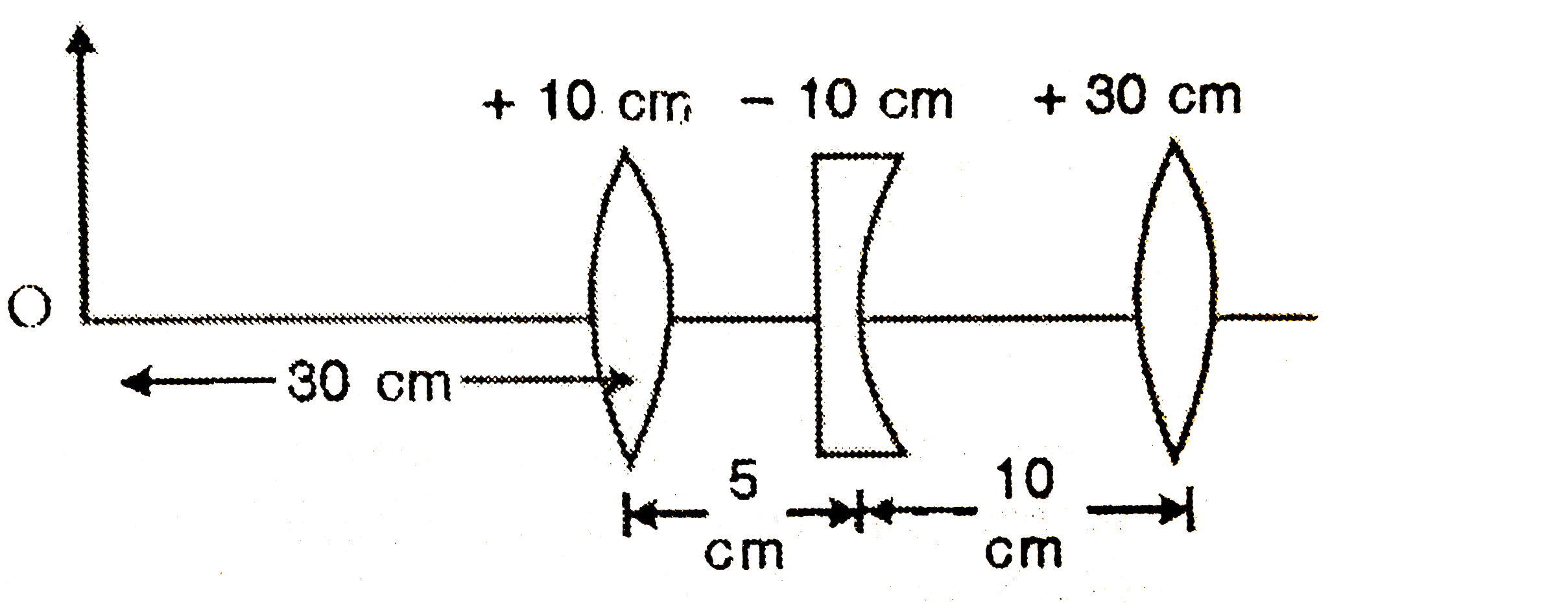Three lenses of focal lengths + 10 cm, - 10 cm and + 30 cm are arranged coaxially as in the [Fig. 9.70] given below. Find the position of the final image formed by the combination.
![Three lenses of focal lengths + 10 cm, - 10 cm and + 30 cm are arranged coaxially as in the [Fig. 9.70] given below. Find the position of the final image formed by the combination.](https://d10lpgp6xz60nq.cloudfront.net/physics_images/U_LIK_SP_PHY_XII_C09_E09_022_Q01.png)
Here for first lens f1=+10cm,u1=−30cm,hence
1v1=1f1+1u1=110+1−30⇒v1=+15cm
Thus, first lens will form an image ly at a distance of 15 cm from lens L1 and the refracted ray passes along the path L1I1. However, distance of I1 from lens L2=15−5=10cm i.e., the point I1 behaves as the focus point of lens L2

It means that the ray L1I1 after refraction from lens L2, start travelling parallel to its principal axis and then is incident on lens L3.
A parallel beam of light on refraction from convex lens L3 gets focussed at its principal focus. Thus, final image I2 is formed at principal focus of lens L3 i.e., I2 is at a distance of 10 cm from lens L3.
Topper's Solved these Questions
- RAY OPTICS AND OPTICAL INSTRUMENTSBOOK - U-LIKE SERIESCHAPTER - RAY OPTICS AND OPTICAL INSTRUMENTSEXERCISE - LONG ANSWER QUESTIONS-II
9 Videos
- RAY OPTICS AND OPTICAL INSTRUMENTSBOOK - U-LIKE SERIESCHAPTER - RAY OPTICS AND OPTICAL INSTRUMENTSEXERCISE - SELF ASSESSMENT TEST (SECTION A)(MULTIPLE CHOICE QUESTIONS)
5 Videos
- RAY OPTICS AND OPTICAL INSTRUMENTSBOOK - U-LIKE SERIESCHAPTER - RAY OPTICS AND OPTICAL INSTRUMENTSEXERCISE - SHORT ANSWER QUESTIONS
54 Videos
- NUCLEIBOOK - U-LIKE SERIESCHAPTER - NUCLEIEXERCISE - Self Assessment Test
10 Videos
- SEMICONDUCTOR ELECTRONICS : MATERIALS, DEVICES AND SIMPLE CIRCUITSBOOK - U-LIKE SERIESCHAPTER - SEMICONDUCTOR ELECTRONICS : MATERIALS, DEVICES AND SIMPLE CIRCUITSEXERCISE - SECTION B
1 Videos
Similar Questions
(a) Under what conditions is the phenomenon of total internal reflection between the critical angle of incidence and the refractive index of the medium.
(b) Three lenses of focal lengths+10 cm, -10 cm and + 30 cm are arranged coaxially as in the figure given below. Find the position of the final image formed by the combination.

View Solution(a) Under what conditions is the phenomenon of total internal reflection of light observed? Obtain the relation between the critical angle of incidence and the refractive index of the medium.
(b) Three lenses of focal lengths +10cm,−10cmand+30cm are arranged coaxially as in the figure given below. Find the position of the final image formed by the combination.

(b) (i) Write a balanced equation showing nuclear fission of Uranium (23592U) nucleus.
(ii) In a nuclear reactor, what is the function of :
(a) Cadmium rods? (b) Graphite rods?
View Solution
Knowledge Check
A convex lens of focal length 30 cm , a concave lens of focal length 120 cm , and a plane mirror are arranged as shown . For an object kept at a distance of 60 cm from the convex lens, the final image, formed by the combination , is a real image , at a distance of :
_E01_195_Q01.png)
|Focal length|=|Focal length|
= 30cm =120cm
_S01_267_Q02.png) A70 cm from the convex lensB60 cm from the convex lensC60 cm from the concave lensD70 cm from the concave lens
A70 cm from the convex lensB60 cm from the convex lensC60 cm from the concave lensD70 cm from the concave lens
A convex lens of focal length 30 cm , a concave lens of focal length 120 cm , and a plane mirror are arranged as shown . For an object kept at a distance of 60 cm from the convex lens, the final image, formed by the combination , is a real image , at a distance of :
_E01_195_Q01.png)
|Focal length|=|Focal length|
= 30cm =120cm
_S01_267_Q02.png)
View SolutionA convex lens of focal length 10 cm is placed coaxially 5 cm away from a concave lens of focal length 10 cm. If an object is placed 30 cm in front of the convex lens, find the position of the final image formed by the combined system.
View SolutionA convex lens of focal length 10 cm is placed coaxially 5 cm away from a concave lens of focal length 10 cm. If an object is placed 30 cm in front of the convex lens, find the position of the final image formed by the combined system.
View SolutionA convex lens of focal length 10cm is placed co-axially 5cm away from a concave lens of focal length 10cm. If an object is placed 30cm in front of the convex lens, find the position of final image formed by the combined system.
View SolutionTwo lenses of focal lengths -20cm and +10cm are put in contact.Find power of the combination
View SolutionAn object is placed at a distance of 10cm to the left on the axis of convex lens A of focal length 20cm. A second convex lens of focal length 10cm is placed coaxially to the right of the lens A at a distance of 5cm from A. Find the position of the final image and its magnification. Trace the path of the rays.
View SolutionAn object is placed at a distance of 10cmm to the left on the axis of convex lens A of focal length 20cm. A second convex lens of focal length 10cm is placed coaxially to the right of the lens A at a distance of 5cm from A. Find the position of the final image and its magnification. Trace teh path of the rays.
View Solution
